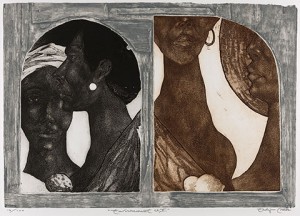
Eldzier Cortor, 1916-2015
Environment, 19??.
About:
Eldzier Cortor, Painter of Scenes From African-American Social Life, Dies at 99
By ELIZABETH A. HARRIS
NOV. 27, 2015
Eldzier Cortor, a painter and printmaker perhaps best known for his elegant paintings of nude black women created when such works were seldom seen in the mainstream art world, died on Thursday at his son’s home in Seaford, N.Y., on Long Island. He was 99.
The son, Michael, confirmed his death.
Figure.
Mr. Cortor’s works are in major museum collections, including those of the Art Institute of Chicago and the Smithsonian American Art Museum. His work was also featured in the inaugural show at the new Whitney Museum of American Art, “America Is Hard to See.”
Classical Study No 37, 1979.
As a young man, Mr. Cortor studied at the Art Institute of Chicago and was employed by the Works Progress Administration’s Federal Art Project, created in 1935 as part of the New Deal to support artists.
He was “charged with depicting scenes of African-American social life in the slums of Chicago’s South Side,” according to the John Simon Guggenheim Memorial Foundation, which awarded him an unrelated fellowship in 1949. With money from the W.P.A., he helped found theSouth Side Community Art Center in Chicago, which is celebrating its 75th anniversary this year.
Dance Composition No 34, 1980s.
In an interview last month with The New York Times, Mr. Cortor recalled an introduction to the rules of race in the South, the life his parents sought to leave behind.
“When I was going down South, I was going down there to paint the Gullah people” living on the Sea Islands off South Carolina, Mr. Cortor recalled. “I caught the bus, and I was sitting in the middle,” he continued. “An older fellow, black fellow, he’s sitting in the complete back, against the bus back, you see. The bus was empty. You see, he got up and came and said, ‘Son, you better come back, in the back here.’”
Around 1950, Mr. Cortor moved to New York City’s Lower East Side, where he lived for the rest of his life.

One of his first moments of popular recognition came in 1946, when Life magazine published one of his figures, a seminude woman. He received prestigious fellowships — including the Guggenheim, which allowed him to travel to Cuba, Jamaica, and Haiti, where he was exposed to new examples of art and culture in the African diaspora.
Abattoire II, 1955.
Demand for his work has grown in recent years, as many black artists have seen a surge in interest, with museums moving away from a Eurocentric view of American art.
Eldzier Cortor was born in Richmond, Va., on Jan. 10, 1916, to John and Ophelia Cortor. According to the Michael Rosenfeld Gallery, which was his primary dealer for many years, Mr. Cortor’s father was an electrician who felt stifled by Southern racism, so he moved the family to Chicago in 1917. Complete information on survivors in addition to his son was not immediately available.
Until the day he died, his son said, Mr. Cortor was still painting.
“The idea is to get someone to pause awhile” instead of walking past a picture. Mr. Cortor said in the recent interview. “You try to just get them to stay with that painting for a while, you don’t just burst past it there. And that’s the idea. If you can get someone, to catch their eye a little bit.” (text New York Times/Courtesy Michael Rosenfeld Gallery, New York)




